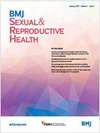‘Repeat abortion’, a phrase to be avoided? Qualitative insights into labelling and stigma
Q Medicine
Journal of Family Planning and Reproductive Health Care
Pub Date : 2016-11-29
DOI:10.1136/jfprhc-2016-101487
引用次数: 21
Abstract
Background In recent years there has been growing international interest in identifying risk factors associated with ‘repeat abortion’, and developing public health initiatives that might reduce the rate. This article draws on a research study looking at young women's abortion experience in England and Wales. The study was commissioned with a specific focus on women who had undergone more than one abortion. We examine what may influence women's post-abortion reproductive behaviour, in addition to exploring abortion-related stigma, in the light of participants' own narratives. Study design Mixed-methods research study: a quantitative survey of 430 women aged 16–24 years, and in-depth qualitative interviews with 36 women who had undergone one or more abortions. This article focuses on the qualitative data from two subsets of young women: those we interviewed twice (n=17) and those who had experienced more than one unintended/unwanted pregnancy (n=15). Results The qualitative research findings demonstrate the complexity of women's contraceptive histories and reproductive lives, and thus the inherent difficulty of establishing causal patterns for more than one abortion, beyond the obvious observation that contraception was not used, or not used effectively. Women who had experienced more than one abortion did, however, express intensified abortion shame. Conclusions This article argues that categorising women who have an abortion in different ways depending on previous episodes is not helpful. It may also be damaging, and generate increased stigma, for women who have more than one abortion.“重复堕胎”,一个应该避免的词?定性洞察标签和柱头
近年来,国际上越来越关注确定与“重复堕胎”有关的风险因素,并制定可能降低堕胎率的公共卫生举措。这篇文章借鉴了一项关于英格兰和威尔士年轻女性堕胎经历的研究。这项研究的委托对象是经历过一次以上堕胎的妇女。除了根据参与者自己的叙述探索与堕胎有关的耻辱之外,我们还研究了可能影响妇女堕胎后生殖行为的因素。研究设计混合方法研究:对430名年龄在16-24岁的女性进行定量调查,并对36名进行过一次或多次堕胎的女性进行深度定性访谈。本文关注的是两组年轻女性的定性数据:我们采访过两次的女性(n=17)和经历过不止一次意外怀孕的女性(n=15)。结果定性研究结果表明,妇女的避孕史和生育生活的复杂性,因此,除了没有使用避孕措施或没有有效使用避孕措施的明显观察外,建立不止一次堕胎的因果模式固有的困难。然而,经历过一次以上堕胎的妇女表现出更强烈的堕胎羞耻感。这篇文章认为,根据以往的情况对堕胎妇女进行不同的分类是没有帮助的。对于多次堕胎的妇女来说,这也可能是有害的,并会产生更多的耻辱。
本文章由计算机程序翻译,如有差异,请以英文原文为准。
求助全文
约1分钟内获得全文
求助全文
来源期刊

Journal of Family Planning and Reproductive Health Care
OBSTETRICS & GYNECOLOGY-
CiteScore
0.84
自引率
0.00%
发文量
0
审稿时长
>12 weeks
期刊介绍:
The trading of Professional, Managerial & Healthcare Publications Ltd has been transferred to its parent company, Keyways Publishing Ltd.
 求助内容:
求助内容: 应助结果提醒方式:
应助结果提醒方式:


